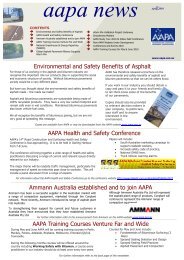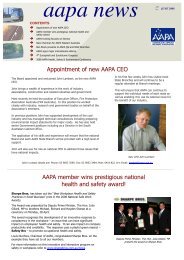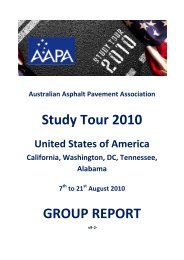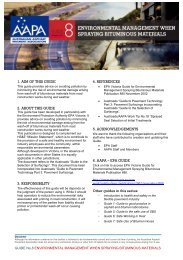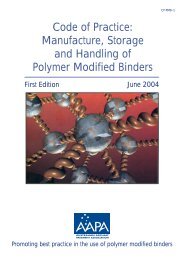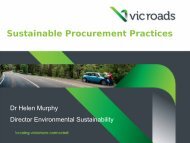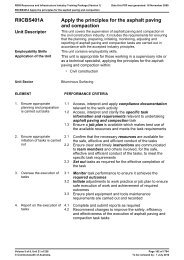keynote address - Australian Asphalt Pavement Association
keynote address - Australian Asphalt Pavement Association
keynote address - Australian Asphalt Pavement Association
- No tags were found...
Create successful ePaper yourself
Turn your PDF publications into a flip-book with our unique Google optimized e-Paper software.
Intermediate Mixes: % RAP Allowed0%10%15%20%25%≥30%n/a
Surface Mixes: % RAP Allowed0%10%15%20%25%≥30%n/a
<strong>Asphalt</strong> Recycling in the USA• <strong>Asphalt</strong> recycling specifications and practicesare inconsistent across the USA• Our goal is to increase average RAP contentto 25% by 2013• Research is underway to resolve technicalissues.• Some perceptions exist that recycled HMA isinferior to all virgin HMA, which stifles theeffort to increase recycling.8
Milled RAPKeep millings fromdifferent projects inseparate stockpiles.Milled RAP can typicallyMilled RAP can typicallybe used as is in HMAwithout further crushing.
RubbleRejected MixMultiple Source RAPPlant WasteSmall Jobs
RAP Crushing & Processingfractionated only4%no further procesingbefore loading6%all crushed to asingle size74%crushing sizedepends on need16%14
Crushed RAP PileOne-size-fits-all approach:Crushing all RAP to pass one screen(e.g.
Fractionated RAP3/4 x 3/16” RAPIn back-3/16” RAP+3/4” RAP16
Variability of RAPTrue or False?• RAP is more variable than virgin aggregate.• Fractionation will reduce the variability ofRAP stockpiles• Single source RAP is more consistent thanprocessed RAP from GOK piles17
RAP QC StatisticsRecycled Hot-Mix <strong>Asphalt</strong> Concrete in Florida: A Variability StudyICAR – 401-1/98RAP propertynAverage(%)Standard Deviation (%)AverageRange<strong>Asphalt</strong> Content 20 5.4 0.30 0.1 to .55% Passing Median Sieve 20 47.9 3.11 1.29 to 5.66% Passing 75 micron Sieve 20 9.1 0.93 0.45 to 2.22Data from p.7 & 8
ICAR‐401‐1/98Based on stockpiles at contractors plant site…• Analysis of variance on the median coefficient ofvariation i revealed that RAP had a lower variationithan virgin aggregates• The statistical analysis revealed that increasing thepercentage of RAP does not increase the coefficientof variation of the mix. (This is in the RAP range of15 to 40% and most of the mixes had between 25‐35percent RAP).• ANOVA for the maximum CV indicated that nosignificant ifi tdifference between any of fthe materials:HMAC, RAP, or virgin aggregate.
RAP Consistency DataGeorgia RAP Stockpiles (Kandhal et. al. Sept. 1997)n% Pass 2.36 mm % Pass 75 µm <strong>Asphalt</strong> ContentAvg. St. Dev. Avg. St. Dev. Avg. St. Dev.Newton County 10 47.5 495 4.95 714 7.14 074 0.74 552 5.52 023 0.23Forest Pk. mlgs. 5 3.60* 3.41 7.02 1.08 5.46 0.31Resaca 10 36.4 2.20 8.72 1.36 5.08 0.21Bryan County 10 42.9 4.63 4.75 0.71 4.83 0.42Lowndes County 10 49.3 4.82 7.36 0.75 5.60 0.48Spartan <strong>Asphalt</strong> 70 58.1 3.5 9.0 0.82 3.8 0.30Pooled data 3.72 0.86 0.3120
More Information onRAP Variability Statistics• Asked for data from about 20 contractorsacross the U.S.• Compiled data for fractionated and non‐fractionated stockpiles• Received data for over 100 stockpiles• Some data was not used (n
Variability: RAP vs. AggregategBased on 74 RAP stockpiles in 14 states, and 60 aggregate stockpiles in 6 states22
Fractionated vs. non Fractionated23
Preliminary Targetsfor RAP ConsistencyRAP propertyMax. StandardDeviation(%)<strong>Asphalt</strong> Content 0.5% Passing Median Sieve 5.0% Passing 75 micron Sieve 1.0Approximately 2/3 of collected data is within these limits
Barriers to Increasing RAP25
Performance of<strong>Asphalt</strong> <strong>Pavement</strong>sContaining 30% RAP26
LTPP SPS‐5: RAP vs. Virgin• Four RAP to Virgin comparison pairs per project– 2” overlay, no mill– 2” overlay with mill– 5” overlay, no mill– 5” overlay with mill• Five performance measurements (annual)– Rutting, mm– IRI, m/km– Fatigue cracking, m 2– Transverse cracking, # per section– Longitudinal cracking, m• 360 comparisons: graphed, tabulated differences,statistical analyses28
SPS‐5 Project Locations29
More Transverse Crackingin Recycled Sections33
Recycled HMA ConclusionsBased on a the long‐term performance of alarge number of projects across NorthAmerica…• <strong>Pavement</strong>s using ≥ 30% RAP perform equal orbetter than virgin pavements in most cases• Transverse and fatigue cracking were observedmore often in pavements with ≥ 30% RAPcompared to pavements with all virgin materials• Further research is exploring environmental andmix design effects of the projects35
Barriers to Increasing RAP36
Current SuperpaveGuidelines for RAP• Tier 1: Up to 15% RAP– use specified binder grade• Tier 2: 15%‐25% RAP– use one full binder grade lower, e.g., PG58‐28 instead of PG 64‐22• Tier 3: Over 25% RAP– use blending charts to determinerequired binder grade
RAP Nomograph‐ High PG Temp.gh Temp perature (C)Critical Hi1009080706050400 10 20 30 40 50 60 70 80 90 100%RAP
Binder Issues• Can we determine RAP binder propertieswithout solvents?• Is traditional blending approach correct?– Is there 100% blending?– Should we adjust the virgin binder grade at all?39
EPc*−1⎡ VMA⎡ ⎛ VMA ⎞ * ⎛ VFA × VMA ⎞⎤1 −⎤100VMA= P ⎢4,200,000⎜1− ⎟ + 3 ⎜ ⎟⎥+ (1 − ) ⎢ +⎥cGPbinderc*⎣⎛⎜20+=⎝650⎛⎝VFA×3 G*VMAVFA×3 G+ ⎜ VMA⎝binder*binder⎞⎟⎠0.58⎞⎠1000.58⎠⎝10000001000001000010,000⎠⎦⎢4,200,000⎣St BunnG* Mastercurves Binder vs Mix Tested3VFAGbinder⎥⎦G*, psi10001001010.1-8 -7 -6 -5 -4 -3 -2 -1 0 1 2log(Frequendy, Hz)G* BinderG* MixST BunnG* calculated vs G* testedTorsion1000000100000G*, psi10000100010010G* mix calculatedG* Mix Tested1400 0.5 1 1.5 2 2.5 3 3.5log(Frequency, Hz)
Recommendations on Testing RAP• <strong>Asphalt</strong> content by ignition oven• Solvent extraction for dolomitic i limestones• RAP Aggregate:– Bulk Specific Gravity is the most important• Gmm & Pb→Gse→Gsb– Gradation– Consensus propertiesIgnition oven– Source properties41
NCAT Test Track RAP Study42
NCAT Test Track RAP Sections1. virgin control mix with PG 67‐222. 20% RAP with PG 67‐22 virgin binder3. 20% RAP with PG 76‐22 virgin binder4. 45% RAP with PG 52‐28 virgin binder5. 45% RAP with PG 67‐22 virgin binder6. 45% RAP with PG 76‐22 virgin binder7. 45% RAP with PG 76‐22 + SasobitAll sections were placed as a 2” mill and fill on existing sections43
No RAPN5-0%RAPPG67-22RAP Sections94.8%Moderate RAPW4-20%RAPPG67-2293.9% 9%W3-20%RAPPG76-2292.0%High RAPW5-45%RAPPG58-28E5-45%RAPPG67-22E6-45%RAPPG76-2295.3% 94.0% 95.5%E7-45%RAPPG76-22+Sasobit96.0%44
Mix QC SummariesMix Virgin Control 20% RAP 45% RAPNMAS 12.5 12.5 12.5Pb 5.8% 5.6 – 5.8% 4.9 – 5.1%Va 2.9% 1.9 – 2.1% 1.7 – 3.6%VMA 15.9% 14.2 – 14.5% 12.5 – 13.9%VFA 82% 85 – 87% 74 – 86%In-PlaceDensity95% 92 – 94% 94 – 96%45
Field Performance46
Performance Observations• Constructability of all RAP sections was verygood. No problems encountered withcompaction. The Sasobit did not appear tohelp compatibility.• Volumetric QC results (low Va, high VFA)were marginal for some sections.• High RAP mixes have had excellent ruttingperformance despite low QC voids.47
Performance Observations• Very low severity cracking near edge ofwheelpaths in a few sections. Some of thesecracks are reflection cracks from underlyinglayers.• All sections continue to be monitored to helpdecide if it is necessary to use a lower virginbinder grade for high RAP mixes.48
Estimated Prices DifferenceCompared to Virgin Mix with PG 67-22Based on $10 Agg., $400 neat asphalt, $585 polymer asphalt, $9 RAP• 20% RAP with PG 67-22………….…. -14.9%• 20% RAP with PG 76-22…………….. +11.3%• 45% RAP with PG 52-28………….….. -36.2%• 45% RAP with PG 67-22 22…………..…. -41 41.4%4%• 45% RAP with PG 76-22………………-11.9%• 45% RAP with PG 76-22 + Sasobit ….. -1.0%10%
Limitations of the2006 Test Track RAP Study• Some RAP mix properties were not satisfactory• Two years of performance is not enough toassess durability so the test sections continueto be evaluated through another cycle• The test sections were so thick that no fatiguecracking was expected, so new thinner fulldepthsections with 50% RAP were built in the2009 test t track cycle to assess fatigue50
Barriers to Increasing RAP51
Supply of RAP• Stable 51%• Declining 24%• Increasing 25%
Quantity of RAP Stockpiled00100Lognormal2080Percent40606040802010000100000 200000 300000Quantity of RAP Stockpiled, tons400000500000
How Much RAP Could Be UsedPer rcent0100204060Empirical CDF of RAP Stockpiled/Typical ProductionLognormalo18278081.973.1604080204356.710000%15%25%35%50%100%150%RAP Stockpiled/Typical Production200%
Findings of RAP Supply Survey• Most HMA producers have a limited supply ofRAP (only 27% of producers have enough RAPto run 25% in all mixes)• Nearly half of producers use the same RAP%in surface and non‐surface mixes• Current RAP management practices aregenerally lacking and can be improved.55
Summary• Many highway agencies are allowingincreased RAP contents.t• Current RAP processing methods providegood stockpile consistency, but there is stillroom to improve.• Methods are being developed to assurehigh RAP content mixes will perform well.• Available RAP supply is the limiting factorfor many plants.56
Thank You57



